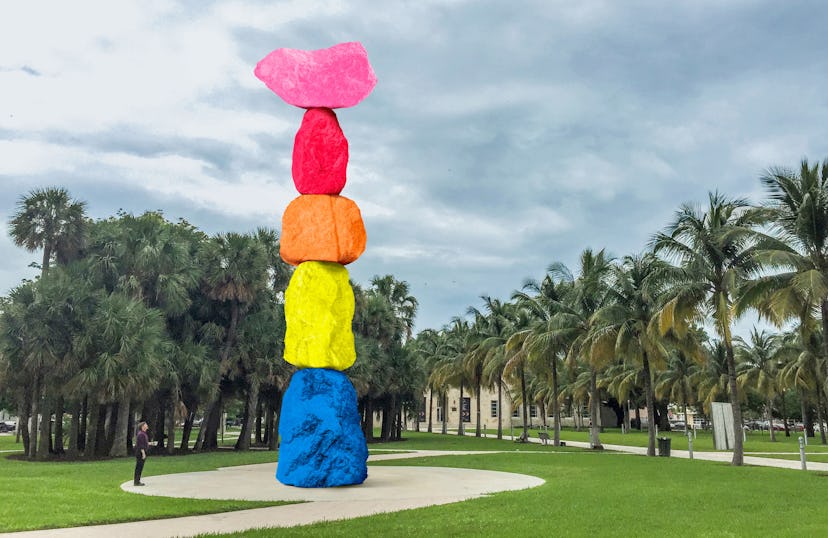Art Basel Miami 2016 Preview: The Beach Is Back
Everything you need to know about this year’s extravaganza, from the must-see museum shows to a starchitect-approved fast food concept.

The Must-See Openings Around Town
Katja Novitskova’s Pattern of Activation (Callithrix Monkey), 2015.
Cultural sprawl hits Miami Beach with the opening of the Art Basel fair in December. In the Design District, the Rubell Family Collection takes stock of our divisive times with “High Anxiety: New Acquisitions,” an exhibition of recent work by Frank Benson, Bunny Rogers, Max Hooper Schneider, and Katja Novitskova, among others. Also on view is a trove of the family’s newly acquired contemporary Brazilian art. Meanwhile, with the completion of the Faena District comes the opening of the Faena Forum, a 43,000-square-foot cultural center designed by the architecture powerhouse OMA in collaboration with impresario-cum-developer Alan Faena, which kicks off with show- (and traffic-) stopping choreographed processions and performances. Julio Le Parc, an innovator in the realm of light and perception, gets his first U.S. museum survey, at the Pérez Art Museum Miami. “Julio Le Parc: Form Into Action” offers more than 100 trippy works by the 88-year-old Argentine artist, a member of the Parisian avant-garde of the 1960s. And though the Bass Museum of Art has moved back its reopening to the spring, the latest addition to its permanent collection, Ugo Rondinone’s 41-foot Day-Glo commissioned sculpture Miami Mountain, situated in Collins Park, will no doubt beckon visitors eager to bask in its glow — or post it on Instagram. — Diane Solway
Thomas Bayrle at the ICA Miami
Thomas Bayrle’s Stalin, 1970.
For half a century, the German artist Thomas Bayrle has built spellbindingly intricate prints by repeating and tweaking single, simple forms. Hundreds of red mustaches form a profile of Joseph Stalin, blue-and-white Chrysler logos morph into a Chrysler sedan, and green hangers take on the image of a man’s head. His process mirrors the “mechanization, assembly-line work, advertising, and reproduction” of society, says Ellen Salpeter, the director of the Institute of Contemporary Art, Miami, which presents the 79-year-old’s first United States museum show (November 29 through March 26, 2017). Among the 150 pieces from the late 1960s to the present, many are so ingenious and subtle in design that “the fact that he did this work long before computers is amazing,” Salpeter notes. For the museum’s soaring atrium, Bayrle is creating a 33-foot-tall Madonna made from metal pipes. “If it achieves what I hope, it will be very spooky and give the entire show an aura of anxiety,” Bayrle says. — Andrew Russeth
Jeffrey Deitch and Larry Gagosian’s “Desire,” at the Moore Building
Right: Jenny Saville’s Odalisque, 2012–2014.
Following the success of their figurative-painting show last December, the dealers Jeffrey Deitch and Larry Gagosian are teaming up again for a second exhibition during Art Basel Miami Beach. “Desire,” which takes over all four floors of Miami’s newly renovated Moore Building, looks at myriad shades of eroticism, from Pablo Picasso to Nan Goldin, and features some 80 works, nearly all of them for sale, in a variety of media. “People may have seen a lot of these works in reproduction,” Deitch says. “But not the originals.” Included are paintings by John Currin and Marilyn Minter, films by Jordan Wolfson and Harmony Korine, and a series of Polaroids by Balthus that, Deitch says, “dilute the barrier between the artist’s life and work.” The same can be said of a 1956 portrait of a woman in a rocking chair by Picasso. “You see within her body permutations of the sexual organs that are shaping her,” notes the artist’s granddaughter Diana Widmaier-Picasso, the curator of the exhibition. “The erotic creates a tension between the artist, the subject, and the viewer,” she adds, as perhaps only a Frenchwoman could. — Diane Solway
Design Miami 2016
A rendering of SHoP’s Flotsam & Jetsam pavilion.
The design world is enjoying its own fun-in-the-sun moment as Design Miami moves into its second decade. This year, the fair’s Panerai Design Miami Visionary Award goes to SHoP, the New York architecture firm whose projects include the sprawling Barclays Center, in Brooklyn. For the plaza in front of the Design Miami tent, SHoP (in collaboration with the Oak Ridge National Laboratory, Branch Technology, and Dassault Systèmes) created Flotsam & Jetsam, a pavilion made of 3-D-printed biodegradable bamboo; after the fair, it will move to a permanent home in Miami’s Design District to serve as a cultural-programming space in partnership with the Institute of Contemporary Art, Miami.
This year, Design Miami is working with the estate of the beloved but under-the-radar graphic designer and illustrator John Alcorn and the Paris-based retailer Maison Kitsuné to create a splashy visual motif — not to mention hats, cardigans, and Kitsuné’s signature sweatshirts. And so that no visitor goes hungry, the on-site café will offer a preview of the soon-to-launch Dean & DeLuca concept takeout stores designed by the Berlin-based architect Ole Scheeren.
Tokujin Yoshioka’s Blossom stool.
Meanwhile, the Design Curio section offers galleries the opportunity to create cabinets of curiosities. Be sure to look in on the Miami gallery Michael Jon & Alan’s presentation of new pieces by Charles Hollis Jones, the California designer known since the 1960s for his glamorous Plexiglas furniture (perfect for your pad in the newly completed Jean Nouvel–designed Monad Terrace, in nearby South Beach Bay), and the Milan gallery Plusdesign’s “Streetscape” exhibition. This evocation of Colombian street festivals includes riffs—by Jonathan Nesci, and Reed Kram and Clemens Weisshaar — on picós, or graffitied makeshift sound systems.
Finally, the Japanese artist Tokujin Yoshioka is the latest contributor to Louis Vuitton’s Objets Nomades collection of travel-inspired furniture and accessories, also on view. His laminated-wood-and-cowhide Blossom stool was inspired by the quatrefoils in the LV logo. For design aficionados in need of immediate gratification, it will be available for purchase at Vuitton’s Design District store. — Pilar Viladas
Watch W’s most popular videos here: